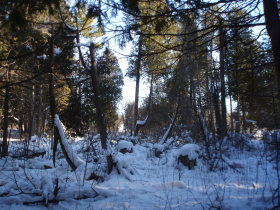 We at Crossroads are obsessed by the weather….and with good reason. A storm in the Arctic can effect our programs. And comfort. You have to wonder about the animals which normally live beneath the Polar Vortex. For wildlife, fur coats are essential.
We at Crossroads are obsessed by the weather….and with good reason. A storm in the Arctic can effect our programs. And comfort. You have to wonder about the animals which normally live beneath the Polar Vortex. For wildlife, fur coats are essential.
In an article in National Wildlife Magazine, Emily and Per Ola D’Aulaire wrote about red fox: “The marvelous insulating quality of its fur enables the creature to sleep outside all year long. Indeed, the animal is apparently content to remain through the winter in such frigid areas as northwestern Canada and eastern Alaska, where temperatures plunge as low as minus 80 degrees.
Curled into a tight ball, with its hairy tail covering the hairless nose and paw pads, a red fox breathes into its silken comforter, circulating warm air and resting as cozily as a man in thermal underwear lying inside a down sleeping bag.”
This time of year, our local fox are developing their winter coats which have several layers. Closest to the skin is a short, thick “undercoat.” This wooly layer provides insulation and is shed in the spring. The beautiful red fur is made up of longer “guard hairs” which act like a windbreaker/raincoat to protect the animal from the elements.
Frequently on winter hikes at Crossroads, we spot porcupines, usually high in evergreen trees. Their quills don’t even show in the winter unless the porkie is upset, and a porcupine up in a tree tends to take most things rather calmly.
Porcupines also have multiple layers of fur. Quills are modified hair used for protection. Then, like fox, porkies have underfur–quite dark, rather short wooly hair. The guard hair–long yellow or whitish hairs– hide the quills and in winter, give the animal a sheepdoggish appearance.
Deer, so sleek and svelte in summer, seem almost dumpy in winter. Their winter pelage is made of long thick hairs which are hollow. They keep body heat in and cold out. Snow falling on a deer may not even melt. The hollow hairs also make the deer buoyant in water, which is fortunate. Deer take to the water with surprising frequency during winter months.
Some animals–ermine and snowshoe hare, for example–change color in winter, but more important than that, grow special fur that enables them to withstand cold. Beaver, mink….. all of our fur-bearing animals boast winter coats which tip the balance toward survival. In the wild, a fur coat is not a luxury. It’s a life preserver.
The family program Saturday at 2:00 will be “Mammals in Winter.” Learners of all ages will visit our wildlife display to learn how the various mammal of Door County make it through the cold season. An optional hike will follow…..if it’s not too cold.
Two nature hikes are scheduled for this week. On Friday at 10:00, the destination will be Crossroads Ida Bay Forest. Hikers will gather at the Collins Learning Center and travel by vehicle for this one hour exploration of the existing trails at our new preserve. At 4:00 on Sunday afternoon, we will hold a “Green and Gold Hike” at Crossroads, and we don’t expect to see any eagles, though it is within the realm of possibility. The last of our fall foliage will show their true colors.

